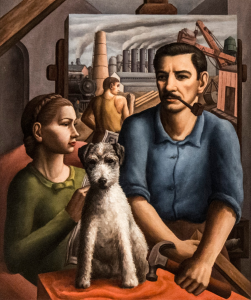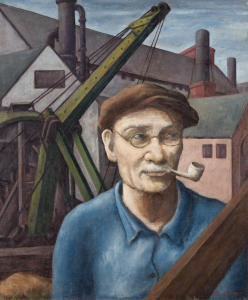
Biography
Paul Raphael Meltsner was born in New York in 1905. With a middle name like Raphael, you might think his parents had ordained that he should be an artist. And, while he did sell his first painting at age 8, his middle name was actually his mother's maiden name and not a forecast of his future fame. He graduated from Flushing High School in 1922 and attended the National Academy of Design. His early artistic career revolved around the theater, and he sold drawings related to the theater to the New York press.
During the Depression Meltsner toured the country in his ancient Ford, and he painted rural landscapes and industrial city scapes, creating simple but iconic images with bold colors. In addition to oils, he created lithographs on similar themes in a similar style. These proved to be quite popular, both with collectors of fine art and the general public.
Meltsner received one commission for a Post Office mural - in Bellevue, OH for his "Ohio" (1937). It showed the agriculture and industry of Ohio in a style similar to his easel paintings. In the mid-1930s Meltsner found a very different artistic niche, when he started painting portraits of celebrities such as Gypsy Rose Lee, Martha Graham and even Albert Einstein. The Einstein portrait fetched a million dollars in the Fifth War Loan Drive in 1944.
By the 1950s Meltsner had left his New York studio and was living in simple surroundings in Woodstock, NY. A 1957 article in Art and Photography magazine described him as "America's Happiest Artist." But tragedy followed, and a 1960 newsclipping said that he had lost his savings and was unable to paint due to psychological problems. Meltsner died in Woodstock in 1966.


Critical Analysis
Meltsner's simple compositions, his bold colors, and his themes of social realist won him a significant following in the 1930s, and his work is well-represented in national museums. Some critics did find his use of color to be unsubtle, but his color was in fact dramatic and compelling, not garish. Interestingly, even when Meltsner moved from scenes of agriculture and industry to portraiture, he retained the same style - with bold colors and simple, but dramatic, compositions.
A nice example of Meltsner's work can be found in his "Paul, Marcella and Van Gogh (No. 2)," which is held by the Nelson-Atkins Museum in Kansas City. The "No. 2" refers to the fact that the original was confiscated by the Nazis in France because of Meltsner's Jewish background; he created a duplicate to replace the original. The painting has another painting in the background with a classic Meltsner industrial scene. The foreground has three figures: his model Marcella, his wire-haired terrier Van Gogh, and Meltsner himself, holding a hammer rather than a paintbrush - a clear allusion to his socialist sympathies. The Museum misidentifies Marcella as Meltsner's wife, although he was a bachelor; other sources refer to her as his daughter, although no evidence is supplied in support of this allegation.
Murals
- Bellevue, Ohio - Post Office: Ohio
References
- About Paul Meltsner, Coronet November (1936).
- Rob Eshman, The Appraisal, Jewish Journal September 27 (2012).
- Harlem Artist Paul Meltsner, New York 1905–1966, Harlem World December 1 (2015).
- In better times for artist Paul Meltsner and companion Van Gogh (Historic Images). Newsclipping from 1960.
- Paul Meltsner (Knowpia).
- Paul Meltsner (Wikipedia).
- Paul Raphael Meltsner (askART).
- Paul Raphael Meltsner (Sartle).
- Paul Raphael Meltsner (1905-1966) (Brier Hill Gallery).